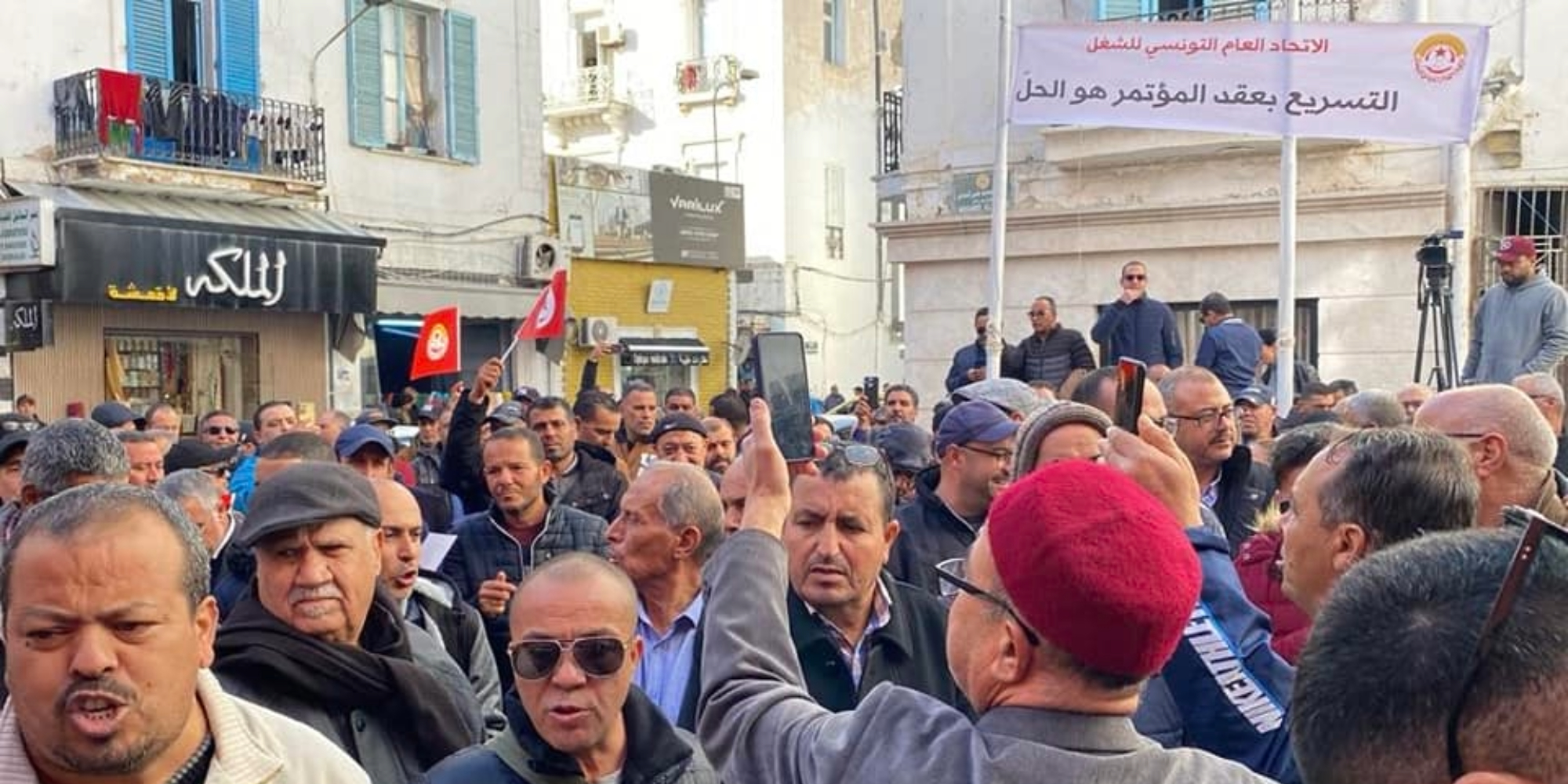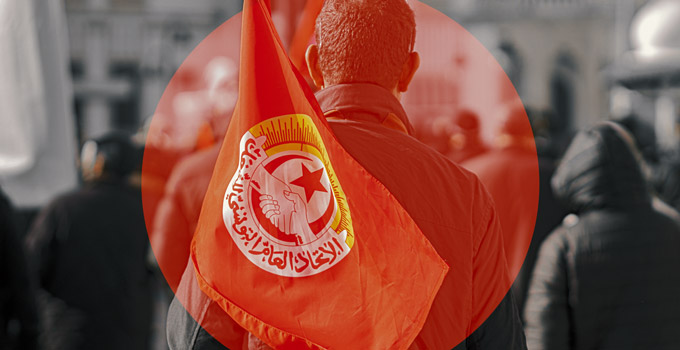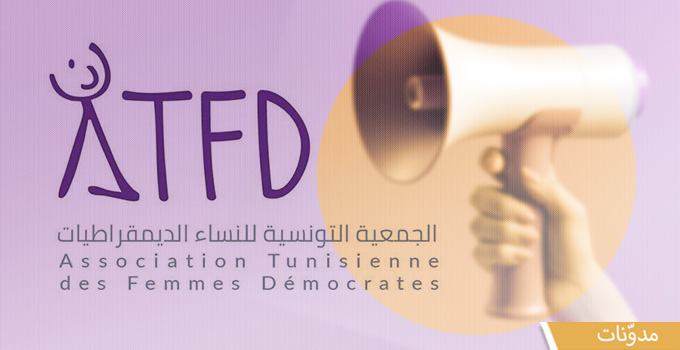Swords are crossed within the executive bureau of the Tunisian General Labor Union (UGTT), the group of “ten” pitted against the group of “five,” while the opposition union has waged war against them both. Initiatives—adopted too late—have been met by apprehension by all concerned parties as the regime in place keeps tabs on the organization and lurks with its files and networks. In the fray, Tunisian workers find themselves utterly disoriented. After one year of a silent struggle and at the start of a brand new year, the only certainty is that the status quo is no longer sustainable.
After months of denial about the reality—and very existence—of the divergent points of view (upon which Nawaat has previously shed light), the decision taken by the group of “five” within the executive bureau (Anouar Ben Kaddour, Monem Amira, Othman Jallouli, Slaheddine Selmi and Taher Mezzi) to bring the conflict into the open marks a turning point. It is a change of course that breaks with Union leadership’s tradition of keeping family matters within the family.
During the first week of December, however, the UGTT’s Assistant Secretary General Anouar Ben Kaddour published “For the preservation of the Union and acceleration of a general congress,” a document which—independently of its content and in its form alone—revealed that it was practically impossible to keep the conflict internal. That document was followed by a sit-in on December 14 organized by the group of “five” and attended by a number of regional and sector-specific union members, as well as members of the National Council.
Ben Kaddour’s appeal and the subsequent sit-in revived an important element from the initiatives undertaken by certain union members in order to reconcile the two sides (10/5) and their supporters in different regional and sector-specific structures. One of these initiatives was submitted on December 20 by the secretary general of Sousse’s regional federation, Kassem Zemni, to Secretary General Noureddine Taboubi.
Nawaat learned from union sources that the initiative in question included moving the UGTT’s general congress to June 2025 in lieu of the original date set for 2027, following the end of the current mandate. But Taboubi rejected this proposal.
Another initiative by former secretary general Houcine Abbassi aimed to find an acceptable solution for the Union’s two conflicting sides. The idea was for the Union to temporarily abstain from publicly sharing any information about the unfolding crisis. Following this proposal, the press conference organized by the group of “five” that was initially planned for Wednesday, December 25, 2024, was postponed until January 8, 2025.

The crisis, nevertheless, remains fundamentally unchanged, with each side maintaining its position. The group of “ten” which includes Secretary General Noureddine Taboubi considers that the National Council held in September completed its work, and that the date of the next general congress shall be in 2027. The group of “five,” on the other hand, believes that the National Council did not complete its work due to compromising irregularities, and never came to a decision regarding the proposal to organize an extraordinary or consensual congress. Either way, they insist upon pushing the date of the congress forward to the first semester of 2025.
None of the current members shall run
The proposal advanced by the group of “five” concerning the general elections congress—whether extraordinary or consensual—builds off the imperative of fixing the date for the first semester of 2025. The group is committed to ensuring that none of the executive bureau’s current members, including Secretary General Taboubi, run in the election.
During one meeting at UGTT headquarters, Place Mohamed-Ali, when the group of “five” met with the representatives of different regions and sectors who support their cause, Assistant Secretary General Slaheddine Selmi affirmed that “legal formulas will be found to prevent the candidacy of all members of the current executive bureau, including the secretary general.” The statement was reiterated by Anouar Ben Kaddour during the protest organized on December 14 outside Union headquarters.
How the crisis began
According to information gathered by Nawaat, the current crisis originated from a simple union dispute in the Sfax region, specifically concerning the congress of the university health section in that area. Taboubi took a stance which opposed that of Sfax’s regional union and the majority of its members headed by Secretary General Youssef Aouadni. As the group of “five” points out, the disagreement escalated into a battle for independence in decisions taken within the organization, and against the centralization of power under the secretary general. For example, the executive bureau had decided that the sit-in on March 4, 2024 would be held outside headquarters at Place Mohamed-Ali. But the Interior Ministry asked Taboubi to move it to Place du Gouvernement, at the Kasbah, in order to facilitate security measures. The request was fulfilled, without any prior consultation within the executive bureau.
Another incident which contributed to and exacerbated the crisis: the leadership’s decision on May 23, 2022 to approve the principle of a general strike in the civil service and public sector, and that the executive bureau would fix the dates. Instead, the date of June 16, 2022 was decided following discussions between Taboubi and the government, and, once again, without prior consultation within the executive bureau. This is confirmed by the group of “five,” as well as several union sources in contact with Nawaat.
In the midst of this tumult, the government attempted to isolate Taboubi from his entourage and to change his image within the organization, blocking his lines of communication with members of government and ministers, including the Minister of Social Affairs. These pressures had the effect of weakening his position within the organization and stripping him of the privilege of intervening at the highest level in order to resolve disputes between the government and unions. The situation halted the implementation of agreements between the UGTT and its structures, and weakened the organization’s capacity to defend the interests of its members as the regime cracked down on union members, some of whom were imprisoned.

On May 18, 2024, the organization’s leadership convened. The meeting set up several commissions tasked with drafting resolutions to be submitted to the National Council for a vote. The union’s internal situation was at the top of the list for these resolutions, including a summary of the latest developments as well as a proposal (point 12) providing two options. The first was to organize an extraordinary elections congress, while the second suggested an agreement to push forward the date of the general congress. In both cases, the date was set for the first semester of 2025.
The UGTT’s internal regulations stipulate (under section two, articles 11-14) that the National Council is the second decision-making authority after the general congress. Its mission is to adopt and monitor the execution of resolutions resulting from the congress, in compliance with the UGTT’s general positions. Its composition reflects a vast representation of the organization’s structures, including the secretaries general of local unions and university branches of sectors within the Union.
Dramatic turn of events at the National Council
During the National Council meeting in September, a third option was added to point 12: keeping the date of the general congress for 2027. When it came time to vote, Taboubi insisted on the application of proportional representation on the basis of article 28 of the UGTT’s internal regulations. The adoption of a proportional vote—which favored Taboubi, who had the support of nine members of the executive bureau—was rejected by those who preferred an earlier date for the congress. This was enough to stir up conflict and push five members of the executive bureau and their supporters within the National Council to leave the meeting.
According to sources who were in the room during the meeting, the withdrawal of the majority of National Council members—612 in total—did not prevent a vote on point 12 by the members who remained. However, those who had vacated did not recognize the legitimacy of the vote. As far as they were concerned, the National Council had not finished its work, and the action taken by Secretary General Taboubi constituted a coercive push to keep the date of the congress set for 2027.
Article 28 of the UGTT’s internal regulations holds that the convocation of an extraordinary congress—at the request of two-thirds of National Council members—takes place on the basis of proportional representation. A complex equation whose variables union members know well. Here, we attempt to simplify the equation as follows:
- Each member of the national executive board has a number of votes equal to the average of the sum of the votes of the regional unions, divided by 24.
- Each secretary general of a general federation (league) has a number of votes determined according to the number of union members within the sector.
- Each secretary general of a regional union has a number of votes determined by the number of union members in the region.
- Each secretary general of a local union has a number of votes determined according to the number of union members within the delegation.
- Each secretary general of a university branch has a number of votes determined by the number of union members affiliated with the sector in the region.
- In addition to other ramifications laid out in the internal regulations which go beyond the scope of this article.
Collective work impossible
The cumulative effect of these disagreements ultimately rendered “collective work within the executive bureau impossible according to the majority of its members, including the secretary general,” we read in a copy of Anouar Ben Kaddour’s publication obtained by Nawaat. Ben Kaddour affirms that “the basic conditions required for collective work—such as cohesion, confidence, harmony and mutual respect among members of the national executive bureau—are no longer present to guarantee unity and the continuity of union action, despite the multiple efforts to surpass differences and bridge the gaps.” It is this stalemate which pushed the organization to hold a first sit-in at Place Mohamed-Ali, with the threat of calling an ongoing sit-in at the organization’s headquarters.

Those who follow union life in Tunisia compare the widening rift to that which the UGTT experienced in the 1980s. At that time, the government attempted to weaken the organization by exploiting its deep internal divisions, following the expulsion of seven members from the executive bureau. While the context and motives were different, this provoked the splintering of the Union and accelerated the creation of a parallel organization, the Tunisian National Labor Union (UNTT) on February 17, 1984. The latter even had a weekly newspaper supported by the government, notably Mohamed Mzali, although those concerned denied this connection. Today, the UGTT is not merely facing internal schisms, but is indeed threatened in its very existence under a regime whose president openly displays his hostility towards intermediary bodies and is committed to removing their role and erasing them entirely from the scene. Union members are perfectly aware of this.
Apart from the executive bureau and its two rivaling factions, the opposition union constitutes one element of pressure that weighs upon the UGTT. This opposition body considers that all members of the executive bureau are responsible for the current crisis ever since the amendment of article 10 within the UGTT’s former internal regulations, which became article 20 during the extraordinary (non-elections) congress in Sousse. It has exercised great caution around what is said in regard to the conflict within the UGTT’s executive bureau, and fears that growing support for the group of “five” might steal the show. Which is why it is calling for the creation of a temporary authority to head the organization and replace the current national executive bureau. This authority would be tasked with overseeing the reconstruction of union structures, from base unions to the intermediary structures of regional unions and general sector-specific unions, until a general congress is held to elect a new executive bureau and another secretary general to replace all of the organization’s current leadership.
Update – Feb 11, 2025
Despite multiple mediation attempts and efforts to resolve internal disputes, frictions continue within the UGTT. On February 6, 2025, five members of the executive board and elements of the UGTT’s National Council launched a sit-in at the union headquarters, demanding an extraordinary congress. This latest development coincided with the Group of Ten’s decision to speak publicly for the first time, through a statement outlining legal procedures for withdrawing confidence from the Executive Board and holding an extraordinary electoral congress. Meanwhile, the union opposition, rejecting both groups’ proposals (the 5 and the 10), intensified its action by initiating an open sit-in at Mohamed Ali Square, starting on the night of January 25-26, 2025. Protesters were prevented by the UGTT leadership from holding a sit-in inside the union headquarters. The police, for their part, prevented them from setting up tents to shelter from the cold and rain. However, the sit-in continues despite the difficult weather conditions. These are all signs foreshadowing explosive developments, under the complicit silence of the authorities. Thus, the government is allowing the unionists themselves to weaken their organization, gradually moving it away from its traditional role of defending workers’ interests and protecting purchasing power. Not to mention its eviction from the most pressing political issues.






iThere are no comments
Add yours